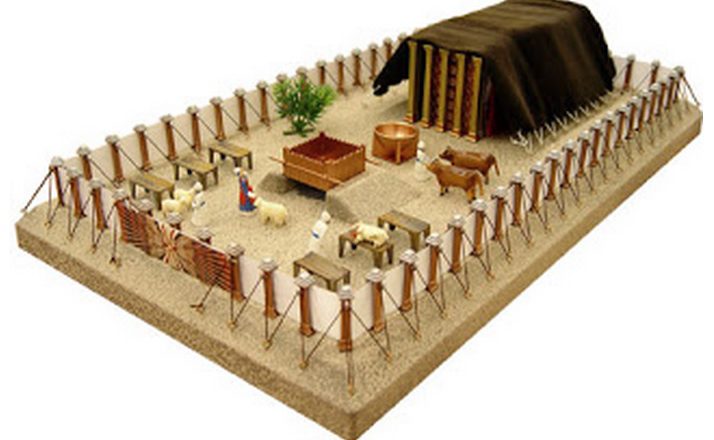From Numbers 7
 Its not uncommon today, that when people move into a new house or place of residence they have a house warming party. They invite all their friends to come over to celebrate. This often includes food, music and tours of the new house.
Its not uncommon today, that when people move into a new house or place of residence they have a house warming party. They invite all their friends to come over to celebrate. This often includes food, music and tours of the new house.
In today’s passage the people of Israel have setup a new house of residence for the Lord. The tabernacle. The place where they will worship Him. Consequently they have their own house warming party complete with gifts and sacrifices.
This post is part of my bible in a year series.
Passage and Comments
Numbers 7 follows in the same vein as chapter 3-4, specifying the duties of the sons of Aaron, the Levites, the Kohathites, Gershonites and Merarites. All families of Levi who looked after the temple. It also looks back to the initial setting up of the tabernacle.
7 On the day when Moses had finished setting up the tabernacle and had anointed and consecrated it with all its furnishings and had anointed and consecrated the altar with all its utensils,
2 the chiefs of Israel, heads of their fathers’ houses, who were the chiefs of the tribes, who were over those who were listed, approached
3 and brought their offerings before the Lord, six wagons and twelve oxen, a wagon for every two of the chiefs, and for each one an ox. They brought them before the tabernacle. (Num 7.1-3)
‘Anointed’, ‘Consecrated’. The proper anointing of the tabernacle involved sacrificial blood. The blood performed a purifying function, wiping away impurities – uncleanliness, sin and death. Leaving the tabernacle and its utensils clean, holy and separate ready for use.
‘On the day’, ‘Finished setting up’. There wasn’t much waiting or rest after the work was done. Moses and the people after finishing felt it was immediately appropriate to celebrate the event.
‘Chiefs of Israel’. The leaders of the tribes recognise the need, they come first.
4 Then the Lord said to Moses, 5 “Accept these from them, that they may be used in the service of the tent of meeting, and give them to the Levites, to each man according to his service.”
6 So Moses took the wagons and the oxen and gave them to the Levites.
7 Two wagons and four oxen he gave to the sons of Gershon, according to their service.
8 And four wagons and eight oxen he gave to the sons of Merari, according to their service, under the direction of Ithamar the son of Aaron the priest.
9 But to the sons of Kohath he gave none, because they were charged with the service of the holy things that had to be carried on the shoulder. (Num 7.4-9)
‘According to their service’. The chiefs gifts were divvied up according to the role of the family in service in the tabernacle. The sons of Kohath had to carry the holy things on their shoulders – as opposed to in a cart. Remember what happened regarding the ark of the covenant (2 Sam 6.3-7)? Thus they couldn’t be assigned the role of transporting these gifts. They had more important things to carry.
10 And the chiefs offered offerings for the dedication of the altar on the day it was anointed; and the chiefs offered their offering before the altar.
11 And the Lord said to Moses, “They shall offer their offerings, one chief each day, for the dedication of the altar.” (Num 7.1-11)
‘One for each day’. There is a fair amount of repetition in the twelve days of offerings that follow. What is important for later hearers of this account is to hear their family names mentioned. There are different types of offerings being made. Grain, burnt, sin and peace offerings. The sheer volume of animals sacrifices indicates rivers of blood were shed in those twelve days.
Story of Israel

The word for “dedication” of the altar is ḥanukkah (vv. 10, 11, 84, 88). This noun, or the verb from the same root (ḥnk), denotes the first use of a structure for the purpose for which it was intended.
Thus a house (Deut. 20:5), city wall (Neh. 12:27), or image (Dan. 3:2–3) could be initiated, as was Solomon’s temple (1 Kings 8:63; 2 Chron. 7:5) and its altar (2 Chron. 7:9). Later ḥanukkah appears in Aramaic for the initiation of the Second Temple (Ezra 6:16–17).
The Jewish holiday of Hanukkah in December celebrates the initiation of a new altar when the Maccabees purified and reconsecrated the Second Temple after its desecration by the persecuting forces of the Seleucid king Antiochus IV Epiphanes (1 Macc. 4:52–59). (Roy Gane, Leviticus, Numbers, The NIV Application Commentary (Grand Rapids, MI: Zondervan, 2004), 549–550.)
Story of Jesus
When Jesus was born people celebrated his coming into the world and brought gifts as well. The magi [the wise men] after listening to king Herod, they went on their way, not to report his whereabouts, rather to celebrate his coming.
9b And behold, the star that they had seen when it rose went before them until it came to rest over the place where the child was. 10 When they saw the star, they rejoiced exceedingly with great joy. 11 And going into the house, they saw the child with Mary his mother, and they fell down and worshiped him. Then, opening their treasures, they offered him gifts, gold and frankincense and myrrh. (Mt 2:9–11)
Like the Israelite chieftains, who brought gifts to the Lord at the sanctuary, and the Magi, who paid rich homage to the our newborn King, we have the pleasure of celebrating Christ’s coming with tangible gifts as well as prayers, songs, and our stories.
When modern people initiate the use of a church and provide it with much needed furniture, equipment and food for God’s work in their community, they are following in the worthy footsteps of these same people who long ago celebrated the bringing into our world the place and person where God dwells with us.
Copyright © Joshua Washington and thescripturesays, 2015-20. All Rights Reserved.

